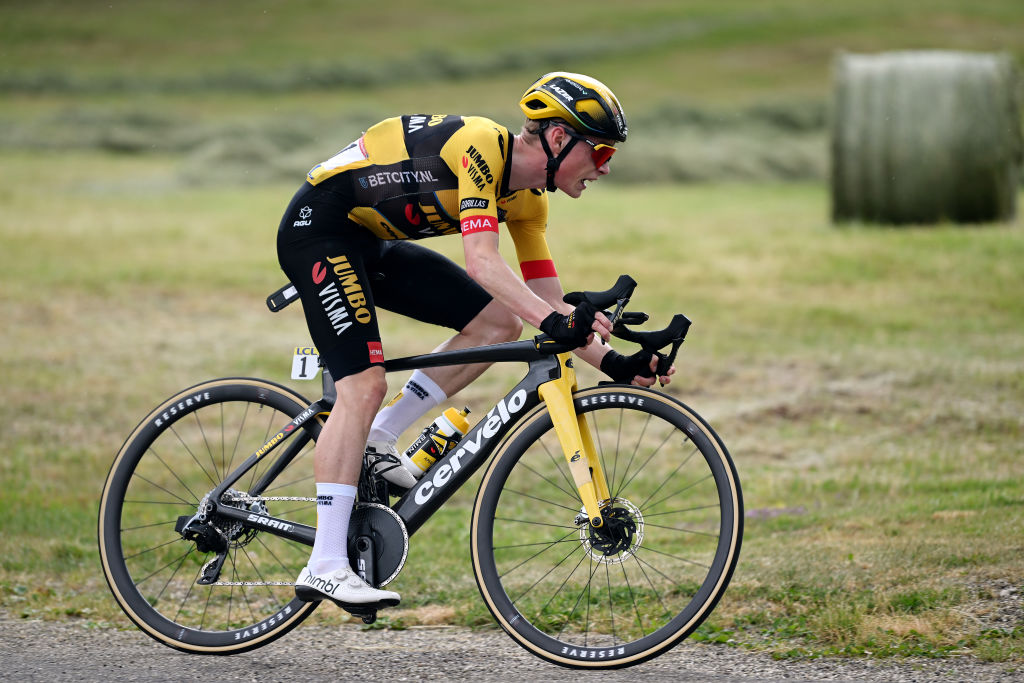
Despite the relatively hilly parcours on stage 1 of the 2023 Tour de France, Jonas Vingegaard (Jumbo-Visma) used a 1X version of SRAM's Red eTap AXS groupset. However, unlike his teammate Primož Roglič at the Giro d'Italia, he opted not to choose the XPLR wide-range gravel cassette.
Following their switch from Shimano to SRAM this season, Jumbo-Visma have trialled almost all of SRAM's vast gearing configuration options, covering both 1X (which sees the bike fitted with just one chainring at the cranks) and 2X (which has two chainrings, and a front derailleur).
They have trialled the options across both road and time trial events, including at the Classics, and even in the mountains. Vingegaard's use of 1x is a first for a major GC contender at the Tour on such hilly terrain, and the team has confirmed he will be using a 50-tooth front chainring with the biggest-available road cassette, a 10-36. Wout Van Aert was also using the 1X groupset, with what we understand was a 10-33 cassette.
1X – or one-by – groupsets have been growing in popularity over the past 12 months for their multitude of apparent marginal gains. The removal of the second chainring and front derailleur will immediately save approximately 250 grams from the bike's weight and increase the bike's aerodynamic efficiency, even when you add back on the chain catcher. In addition, the central chain line it enables is marginally more efficient, and the ability to run extremely large chainrings, as seen on Victor Campanaerts' Classics bike, is another benefit.
Of all Jumbo-Visma riders, Wout Van Aert was among the first to try the tech on the road when he used the setup during the Spring Classics, including at Paris-Roubaix and Strade-Bianche. But it was Roglič who made headlines when, on the penultimate stage of the Giro d'Italia, he swapped to a bike fitted with the brand's 'gravel-specific' XPLR groupset; with a 44-tooth single chainring and a wide-range 10-44-tooth cassette.
According to the team's Head of Performance Equipment, Jenco Drost, Roglič's desire for a high cadence was the primary motivation for the use of that groupset, but the efficiency gain of running a larger chainring and larger cassette sprocket was a nice side effect. Despite Roglič's success – he went on to win the Giro, albeit with 30 seconds of panic caused by a dropped chain – Cyclingnews can reveal that the same XPLR groupset won't be making an appearance at the Tour, as Drost believes no road on this year's route is steep enough to need it.
The shift to 1X groupsets has been most prevalent in time trials, and has also been trialled by Ineos Grenadiers in this discipline, courtesy of having aero expert and former Hour Record holder, Dan Bigham, on the team's staff. In time trialling, aerodynamic marginal gains can often make the biggest difference to a result, and they are often flat enough not to need the lower gears offered by the small chainring.
The main downside to switching to 1X is a reduction in available gear options, but this is where larger cassettes come into play. The wider range cassettes provide easier 'easy' gears at the bottom of the cassette, allowing riders to have the 'best of both worlds', albeit with the compromise of larger steps between each gear.
Interestingly, this isn't the first time 1X has reared its head in the peloton. Five years ago in 2018, Aqua Blue Sport were given 3T Strada bikes that could only accommodate a single chainring. It was met with mixed reception from riders, and the team folded later that same season.
Its resurgence, however, does point to the continued evolution of pro cycling's collective mindset. Going back a little further - approximately 10 years - and an 11-28 cassette was considered unnecessarily large, with only a few riders using them in the high mountains. Nowadays, 11-28 is among the smaller cassettes on the market, and it's not uncommon to see 10-33T or 10-34T cassettes.
A representative from SRAM also told Cyclingnews that Vingegaard and his Jumbo-Visma teammates will continue to use 1X groupsets on 'select' stages throughout the rest of the three-week Tour. If the Dane goes on to retain his title, it'll be a big feather in the 1X cap, for sure.







